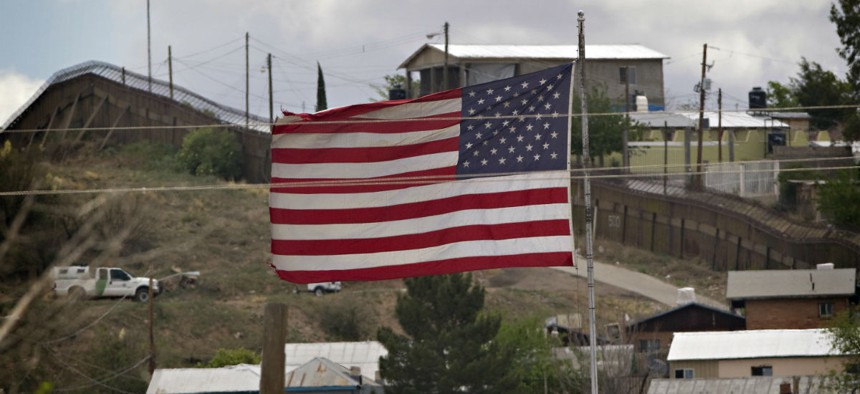
A U.S. flag flies over the border in Nogales, Ariz., in 2010, when President Obama sent National Guard troops to Arizona. Matt York / AP file photo
Trump's Push to Militarize the U.S.-Mexico Border Could Repeat a Costly Obama Failure
Operations under Obama and George W. Bush ended up taking money from other Defense projects and causing diplomatic problems.
Donald Trump has been unable to get funding from Congress for the “big, beautiful wall” he promised voters he would build on the U.S.-Mexico border, so he offered up a new plan Tuesday (April 3): install U.S. military troops there instead.
“Until we can have a wall and proper security, we’re going to be guarding our border with the military,” Trump said during his public remarks as he was meeting with Baltic leaders at the White House. “That’s a big step,” he said. “We really haven’t done that before.” Trump said he had already discussed the idea with Defense Secretary James Mattis. The White House said later Tuesday the National Guard would be mobilized along the border.
Adding troops to the United States’s nearly 2,000-mile-long border with Mexico isn’t a new idea. Both presidents Barack Obama and George W. Bush tried it. Both times, U.S. diplomats, local business people, and some lawmakers called it an expensive failure (paywall).
In July of 2010, Obama ordered up “Operation Phalanx,” dispatching 1,200 National Guard troops to the border. The Obama order was an extension of “Operation Jump Start,” a 2006 Bush policy that sent 6,000 National Guard troops to the U.S.-Mexico border, where they did everything from help seize drugs to rescue a drowning Central American woman. The U.S. Customs and Border Protection (CBP) reported at the time:
Two Texas guard members working in an entry identification capacity nearby responded to the call for assistance. Disregarding their own safety, the guardsmen jumped into the water to save the drowning woman, pulling her from the depths of the muddy Rio Grande River.
Operation Phalanx cost $145 million for 14 months, while Operation Jump Start cost $1.2 billion over two years. Both operations took resources from other Defense Department projects, while failing to establish a transparent U.S.-Mexico border security policy, the Government Accountability Office said in a critical 35-page report. State Department officials worried the operations would hamper their cooperation with Mexican law enforcement authorities, the report said.
Complicating matters, Pentagon rules meant that the National Guard was unable to confront or detain suspects, thus they needed to call CBP officers if they saw someone they suspected of smuggling drugs or entering illegally.
Like many of Trump’s off-the-cuff policy announcements, the notion of putting military on the U.S.-Mexico border seemed to come as a complete surprise to the agencies involved and the people who could be affected.
“That’s the first we’re hearing of it,” said one union representative for border agents. An official with the Texas Border Coalition, a group of border lawmakers, mayors, and business people, said she was trying to find out more information. Spokespeople at the CBP and the Homeland Security Department said they had no comment.






